Ben Forta's Blog, page 30
December 16, 2014
AIR 16 Beta Updated
 We released Flash Player 16 last week, and AIR 16 is on the way. In fact, the updated beta of AIR 16 is now on Adobe Labs.
We released Flash Player 16 last week, and AIR 16 is on the way. In fact, the updated beta of AIR 16 is now on Adobe Labs.
Published on December 16, 2014 13:19
Reviewing littleBits
I love electronics, and I love introducing others, especially kids, to the wondrous creativity of electronics and programming. Over the years I've tinkered with everything from Radio Shack all-in-one kits to Arduinos to collections of oddball components to Lego Mindstorms to purpose specific kits to Raspberry Pis to ... well, just about every option out there. I've tried them all and then some, and have developed some pretty strong opinions about how to introduce kids to electronics and programming. And no, I don't have a favorite option. Or rather, I didn't, until I discovered littleBits.As the name suggests, littleBits are a collection of, well, little bits of electronics. Each component comes mounted on a small plastic base that magnetically connect to each other (and only connect correctly).
So what do the bits actually do? Well, their mounts are color coded:
Blue bits are power sources, and you can use USB power, rechargeable coin batteries, or a 9V battery (what us old folks may refer to as transistor batteries).
Pink bits are inputs, simple things like buttons and switches and dimmers, and more complex things like remote triggers and sound sensors and oscillators.
Green bits are outputs, like LEDs and speakers and motors.
Orange bits are all about connectivity, from simple wires to connect two other bits, to branches and forks allowing for more complex connections, to logic gates (AND, OR, XOR, etc.), to wireless transmitters and receivers, to custom Arduino boards and cloud clients.
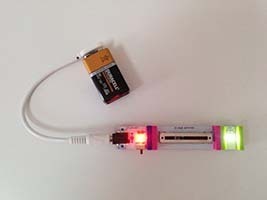
Here's a simple example. Bits are assembled left to right, so first comes a power source, and then a slide dimmer, and finally an . Turn the power source on, and then slide the dimmer up and down and see the LED glow brighter or dimmer. Pretty simple. But that simplicity encourages tinkering. Remove the slide dimmer and replace it with a rotating dimmer, or swap the dimmer for a button, what happens then? And what if a latch is then inserted after the button? And then replace the LED with a bargraph bit that lights up additional LEDs. And so on.
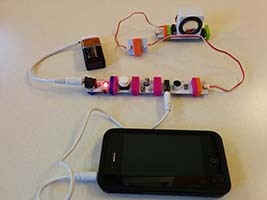
And then try something more complicated. Again, bits are assembled left to right, so first comes power. Next comes a button which usually remains on when pressed and turns off when released, but this button is followed by a timeout bit, so when the button is pressed it remains on until the timeout is reached (timeout is adjusted using a little screw on the bit). Next comes a microphone bit which, as its name suggests, records audio, but which also features an audio in jack which I'm using here to receive audio from an iPhone. Next come a couple of wires allowing the last bit, the speaker, to be placed further away. The end result? Press the button and music plays on the speaker for a designated amount of time, and then the speaker turns off. You can imagine doing something like this for a doorbell perhaps.
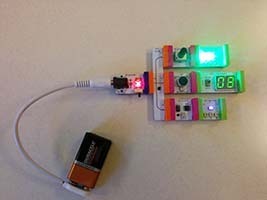
Ok, one last example, and this time we'll play with multiple sensors and outputs. Again, we start with power, and then comes a fork bit to create multiple paths. The top path has a dimmer bit, adjust it to change the lights on the bargraph bit. The middle path is a sound sensor which reports the sound level on a number bit. The bottom path is a pulse bit (once again, pulse speed is controlled using a little screw) which pulses an RGB LED bit.
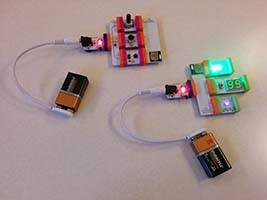
Pretty cool, but we can make it even better. Here I've separated the three inputs from the three outputs, and inserted wireless transmitter and receiver bits which allows for up to three channels to be transmitted over a 2.4GHz radio wave. Obviously, this requires an additional power supply for the receiving end, but other than that it works just as before, and all of the complexities of wireless communication are hidden from you, it just works.
There's a lot more. An Arduino bit lets you embed your own programming into the mix, the cloudBit lets you build projects that connect to APIs, including IFTTT. There are also prototyping options for building your own bits, optional mounting boards, and (drumroll please) adapters to connect bits to Lego. Seriously, Lego plus electronics!
The only downside is the price. Considering that an LED costs less than 20 cents, you're paying a premium for a $7.95 LED bit. The cost goes down if you buy kits instead of specific bits, but it's still not as cheap as tinkering with individual components.
So, is it worth it? Well, I kind of gave it away upfront. I am a huge fan of littleBits, and here's why:
littleBits provide kids with instant gratification in a way that most introductory electronics can't.
These things truly encourage tinkering. Kids won't just build something and let it be, they'll swap bits and tweak and adjust, and that's priceless.
One of the problems that beginners have with more complex kits is getting past the fear that they'll break something. And indeed, that's easy to do, we've all blown too many LEDs thanks to forgetting a resistor. littleBits won't break. Mess up and your experiment won't function, but there's no risk of damaging bits and pieces, and that's really important in encouraging further experimentation.
The kits come with wonderful instructions that encourage the use of cardboard, scissors, tape, and more, as much as they do electronics. The combination is inspiring and completely unintimidating.
The littleBits site has lots of great lessons and examples, and the team has been really good about continually posting new (and seasonally relevant) content.
Lego interoperability. Need I say more?
littleBits are not the end all. Their incredible simplicity comes with a cost in that kids will not be exposed to the fundamentals of electronics, even something as basic as circuits is deliberately concealed. And so at some point you will want to expose kids to a level beneath littleBits. But for beginners and younger kids (and anyone young at heart), littleBits are a winner.
littleBits are highly recommended.
So what do the bits actually do? Well, their mounts are color coded:
Blue bits are power sources, and you can use USB power, rechargeable coin batteries, or a 9V battery (what us old folks may refer to as transistor batteries).
Pink bits are inputs, simple things like buttons and switches and dimmers, and more complex things like remote triggers and sound sensors and oscillators.
Green bits are outputs, like LEDs and speakers and motors.
Orange bits are all about connectivity, from simple wires to connect two other bits, to branches and forks allowing for more complex connections, to logic gates (AND, OR, XOR, etc.), to wireless transmitters and receivers, to custom Arduino boards and cloud clients.

Here's a simple example. Bits are assembled left to right, so first comes a power source, and then a slide dimmer, and finally an . Turn the power source on, and then slide the dimmer up and down and see the LED glow brighter or dimmer. Pretty simple. But that simplicity encourages tinkering. Remove the slide dimmer and replace it with a rotating dimmer, or swap the dimmer for a button, what happens then? And what if a latch is then inserted after the button? And then replace the LED with a bargraph bit that lights up additional LEDs. And so on.

And then try something more complicated. Again, bits are assembled left to right, so first comes power. Next comes a button which usually remains on when pressed and turns off when released, but this button is followed by a timeout bit, so when the button is pressed it remains on until the timeout is reached (timeout is adjusted using a little screw on the bit). Next comes a microphone bit which, as its name suggests, records audio, but which also features an audio in jack which I'm using here to receive audio from an iPhone. Next come a couple of wires allowing the last bit, the speaker, to be placed further away. The end result? Press the button and music plays on the speaker for a designated amount of time, and then the speaker turns off. You can imagine doing something like this for a doorbell perhaps.

Ok, one last example, and this time we'll play with multiple sensors and outputs. Again, we start with power, and then comes a fork bit to create multiple paths. The top path has a dimmer bit, adjust it to change the lights on the bargraph bit. The middle path is a sound sensor which reports the sound level on a number bit. The bottom path is a pulse bit (once again, pulse speed is controlled using a little screw) which pulses an RGB LED bit.

Pretty cool, but we can make it even better. Here I've separated the three inputs from the three outputs, and inserted wireless transmitter and receiver bits which allows for up to three channels to be transmitted over a 2.4GHz radio wave. Obviously, this requires an additional power supply for the receiving end, but other than that it works just as before, and all of the complexities of wireless communication are hidden from you, it just works.
There's a lot more. An Arduino bit lets you embed your own programming into the mix, the cloudBit lets you build projects that connect to APIs, including IFTTT. There are also prototyping options for building your own bits, optional mounting boards, and (drumroll please) adapters to connect bits to Lego. Seriously, Lego plus electronics!
The only downside is the price. Considering that an LED costs less than 20 cents, you're paying a premium for a $7.95 LED bit. The cost goes down if you buy kits instead of specific bits, but it's still not as cheap as tinkering with individual components.
So, is it worth it? Well, I kind of gave it away upfront. I am a huge fan of littleBits, and here's why:
littleBits provide kids with instant gratification in a way that most introductory electronics can't.
These things truly encourage tinkering. Kids won't just build something and let it be, they'll swap bits and tweak and adjust, and that's priceless.
One of the problems that beginners have with more complex kits is getting past the fear that they'll break something. And indeed, that's easy to do, we've all blown too many LEDs thanks to forgetting a resistor. littleBits won't break. Mess up and your experiment won't function, but there's no risk of damaging bits and pieces, and that's really important in encouraging further experimentation.
The kits come with wonderful instructions that encourage the use of cardboard, scissors, tape, and more, as much as they do electronics. The combination is inspiring and completely unintimidating.
The littleBits site has lots of great lessons and examples, and the team has been really good about continually posting new (and seasonally relevant) content.
Lego interoperability. Need I say more?
littleBits are not the end all. Their incredible simplicity comes with a cost in that kids will not be exposed to the fundamentals of electronics, even something as basic as circuits is deliberately concealed. And so at some point you will want to expose kids to a level beneath littleBits. But for beginners and younger kids (and anyone young at heart), littleBits are a winner.
littleBits are highly recommended.
Published on December 16, 2014 11:27
December 15, 2014
Adobe Creative SDK For Android
 Creative SDK has been powering all sorts of iOS apps (our own and 3rd party) for a few months now. And the team has just announced that now Android devices can share the love.
Creative SDK has been powering all sorts of iOS apps (our own and 3rd party) for a few months now. And the team has just announced that now Android devices can share the love.
Published on December 15, 2014 10:59
December 12, 2014
Fotolia To Join Creative Cloud
 Fotolia is devoted to offering affordable creative imagery with a crowdsourced library of over 34,000,000 royalty-free images, vectors, illustrations and video footage clips in 23 countries and in 14 languages. And we've announced that Fotolia is joining Creative Cloud.
Fotolia is devoted to offering affordable creative imagery with a crowdsourced library of over 34,000,000 royalty-free images, vectors, illustrations and video footage clips in 23 countries and in 14 languages. And we've announced that Fotolia is joining Creative Cloud.
Published on December 12, 2014 11:42
December 9, 2014
Flash Player 16 Released
Published on December 09, 2014 19:16
Security Hotfix For ColdFusion 10 And 11
 The ColdFusion team has released a security hotfix for ColdFusion 10.x and 11.x to provent a possible DoS attack (this one does not affect CF9).
The ColdFusion team has released a security hotfix for ColdFusion 10.x and 11.x to provent a possible DoS attack (this one does not affect CF9).
Published on December 09, 2014 06:13
December 4, 2014
Getting Started With Digital Photography
 If you are new to digital photography, and want to review basics including when and how to use Lightroom and Photoshop, check out the new Creative Cloud Photography Tutorials page. You'll find short, focused, highly relevant tutorials, and we've got more on the way.
If you are new to digital photography, and want to review basics including when and how to use Lightroom and Photoshop, check out the new Creative Cloud Photography Tutorials page. You'll find short, focused, highly relevant tutorials, and we've got more on the way.
Published on December 04, 2014 09:38
December 3, 2014
Grab Your Do Not Disturb Door Hanger
Published on December 03, 2014 13:49
December 2, 2014
Make Your Site Feel Faster By Changing Colors
 Dave Ericksen has posted a really interesting article on how to make your site feel faster by changing colors. Dave presents research on how hue, chroma, and brightness all impact perceived performance.[image error]
Dave Ericksen has posted a really interesting article on how to make your site feel faster by changing colors. Dave presents research on how hue, chroma, and brightness all impact perceived performance.[image error]
Published on December 02, 2014 13:19
November 26, 2014
PhoneGap Developer App 1.4 Released
 PhoneGap Developer App lets you develop locally then see the changes instantly on your mobile device, without being limited by device APIs that aren't available in web browsers. PhoneGap Developer App 1.4 has been released providing an update to Cordova 4.0.0 as well as support for the the latest releases of all of the official plugins.
PhoneGap Developer App lets you develop locally then see the changes instantly on your mobile device, without being limited by device APIs that aren't available in web browsers. PhoneGap Developer App 1.4 has been released providing an update to Cordova 4.0.0 as well as support for the the latest releases of all of the official plugins.
Published on November 26, 2014 19:27
Ben Forta's Blog
- Ben Forta's profile
- 6 followers
Ben Forta isn't a Goodreads Author
(yet),
but they
do have a blog,
so here are some recent posts imported from
their feed.



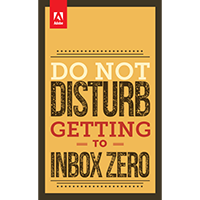 Oh, this one was made for me! Grab your
Oh, this one was made for me! Grab your 
